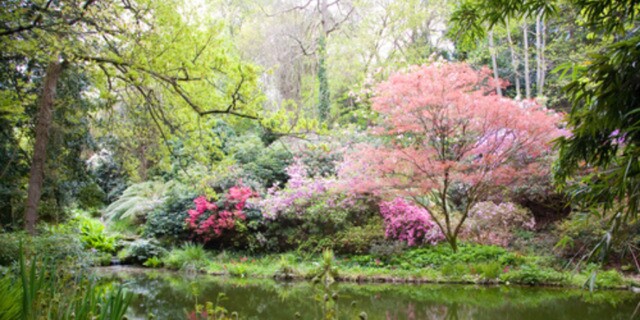The May pick for LDS Living Book Club is Eve and Adam by Melinda Wheelwright Brown. Follow the LDS Living Book Club Instagram for weekly insights with the author.
With more than 60,000 species of trees on earth, it makes sense that we assign names to differentiate between them. We assume the Garden of Eden had a vast assortment of trees, but we learn the names of only two—the tree of life and the tree of knowledge of good and evil.1 These names don’t follow our typical English pattern for naming trees. We call a tree that produces cherries a cherry tree; a tree that grows pears is a pear tree. Perhaps a closer look at these two trees’ unique names will help us better understand their unique place of honor within the garden.
Let’s start with the tree of life. Depictions, tales, and representations of the tree of life are countless and widespread among religions, across cultures, and throughout time. Historically, a monarch’s “royal scepter represented a life-giving branch of the tree of life.”2 In the Middle Ages, Christ’s cross was often depicted as being made from the tree of life.3 The sacred menorah, with its seven branches, brings light like the tree of life.4 Even our genealogical depictions, “family trees,” symbolize the tree of life. The tree of life seems to be everywhere! But biblically it receives very little attention; there are only three brief mentions of the tree of life in the Genesis narrative.5 Later, in Proverbs, it’s referred to metaphorically on four fleeting occasions.6 But in the final chapter of the New Testament, almost 2,000 pages later, in nearly the last verse of the entire Bible, the tree returns for the denouement. Perhaps it is the combination of the bookended imagery of Genesis and Revelation that has led to the tree’s widespread and long-lasting cultural influence. Here, in John the Revelator’s final plea, we have three powerful verses that highlight the eternal significance of the tree of life:
And, behold, I come quickly; and my reward is with me, to give every man according as his work shall be. I am Alpha and Omega, the beginning and the end, the first and the last. Blessed are they that do his commandments, that they may have right to the tree of life, and may enter in through the gates into the city. (Revelation 22:12–14; emphasis added)
In these verses, I hear powerful prophetic echoes reminiscent of “The Living Christ: The Testimony of the Apostles.” That beautiful document uses similar wording as it encapsulates the mission of “the Great Jehovah of the Old Testament, the Messiah of the New”:
- “Each of us will stand to be judged of Him according to our works and the desires of our hearts.”
- “I am the first and the last; I am he who liveth, I am he who was slain” (D&C 110:3–4).
- “His way is the path that leads to happiness in this life and eternal life in the world to come.”
These verses and phrases, added to our comfortable familiarity with Lehi’s vision of the tree of life in the Book of Mormon, as well as many other references in our Restoration scriptures and sacred temple liturgy, make it clear that the tree of life could more accurately be considered the tree of eternal life. Or, to rephrase by applying basic botanical nomenclature, we might call it “the eternity tree.”
► You may also like: Get to Know Mother Eve and Father Adam with the LDS Living Book Club Pick for May: “Eve and Adam”
Since the laws of nature dictate that fruit is directly related to the tree from which it comes—in other words, “after its kind”—the fruit of “the eternity tree” would be expected to have eternal qualities and characteristics. None of our various garden accounts detail Adam and Eve’s experience eating this fruit, but Lehi describes in detail what he tasted in his vision. He called it the sweetest fruit he had ever eaten, the whitest thing he had ever seen. It was “desirable to make one happy,” and “it filled [his] soul with exceedingly great joy.”7 For further emphasis, Nephi later explained, it was “desirable above all other fruits” and “the greatest of all the gifts of God,”8 just as we would expect the “eternity tree’s” fruit to be. Lehi and Nephi wanted nothing more than to share it with their family because “eternal life with our loved ones is sweeter and more desirable than any other thing.”9
Now, let’s turn our attention to the other tree, the tree of knowledge of good and evil. We’ve already determined that its fruit needed to be eaten to enable growth and development, and that it was divinely designed to taste delicious. Like the “eternity tree’s” fruit, it was desirable. Yet, like Eve’s so-called apple, this tree has historically been unfairly maligned.
When we are presented with pairs, like these two trees, our minds often slot them into a dualistic structure, taking a mental shortcut to make sense of their relationship. We dichotomize them, even if applying a complementary framework might prove a better fit. This seems to have been the sad fate of the tree of knowledge of good and evil. When seen as the opposite of the marvelous tree of life, the tree of knowledge of good and evil looks like the dreadful tree of death. But it doesn’t make sense that delicious, desirable, essential fruit would come from a terrible tree. A closer look at its name helps restore respect to this equally precious tree.
With a good understanding of English syntax, specifically prepositions and prepositional phrases, we can thoughtfully reorder the words and call this “the good-and-evil knowledge tree.” The descriptor, “good-and-evil,” used to describe the kind of knowledge this tree gives, employs a literary device intended to designate a spectrum. By definitively noting the two extremes, a creative storyteller paints a picture of the full range of options. So “good-and-evil knowledge” describes all knowledge—the full range of moral distinctions—black and white and all the grays in between.10 President Wilford Woodruff stated that this tree’s fruit was ordained to be eaten, “in order that [humanity] might know both good and evil by passing through this school of experience which this life affords us.”11 How sensible that eating this tree’s fruit provided entrance to mortality,12 since the tree itself represented mortality’s precious learning experience. “The fruit tree yielding fruit, after [its] kind.”13 This is no terrible tree, just as mortality is no terrible punishment. This leads us to the same conclusion Elder B. H. Roberts makes in his book The Truth, the Way, the Life: “Let it be observed that the Tree of Knowledge, even though the Tree of Death, is nowhere called an ‘Evil Tree,’ or its fruit bad. . . . Rather to the contrary: it is included among the ‘trees pleasant to the sight, and good for food,’ in the same verse in which it is named (Genesis 2:9).”14
► You may also like: Likening Leaving the Garden to a Child Departing for College
This makes logical sense, since we have been taught repeatedly that mortality is a necessary phase of life on our journey toward salvation and exaltation. Elder Jeffrey R. Holland recognized that necessity when he stated that “inherent in the fruit of the tree of knowledge of good and evil” is “the path toward growth and godhood.”15
Thinking of the tree of knowledge of good and evil as the “mortality tree” makes it easy to recognize it as the “eternity tree’s” divine complement, instead of its destructive opponent, since the best proof of complementarity between two things is when neither matters without the other, when the absence of one renders both meaningless. This is precisely the relationship between mortality and eternal life, the relationship that set up the perfect conditions for the plan of salvation to proceed.
Lead image: Shutterstock
Eve and Adam offers a fresh and insightful perspective into the perfect plan of happiness. With clarity and careful thought, it presents a solid case for the necessity of a firm understanding of the honor due to our glorious Mother Eve as well as Father Adam. Available now at DeseretBook.com.
- Genesis 2:9; Moses 3:9; Abraham 5:9. Note that the tree of knowledge of good and evil is occasionally referred to as the tree of the knowledge of good and evil; see Genesis 2:17 and Moses 3:17.
- Peterson, “The Qur’anic Tree of Life,” 198.
- In his essay “The Tree of Life in the New Testament and Christian Tradition,” BYU professor and biblical scholar John W. Welch writes: “The tree of life in the Garden of Eden possessed the regenerative power to allow Adam and Eve to live forever. Drawing on this imagery, Christians readily saw in the resurrection of Jesus Christ the culmination of this same saving and immortalizing power. Thus, the symbolism of the tree fit snugly together with the gospel message of the earliest Christian writers. . . . The cross itself was soon interpreted and represented as the tree of life in Christian texts and art.” His essay includes several excellent photographed examples of medieval European artwork depicting Christ’s cross as the tree of life (Welch, “The Tree of Life in the New Testament and Christian Tradition,” 82–83, 95).
- Yarden, The Tree of Light, 35–40.
- Genesis 2:9; 3:22, 24.
- Proverbs 3:18; 11:30; 13:12; 15:4.
- 1 Nephi 8:10–12.
- 1 Nephi 15:36.
- Pearson, “Stay by the Tree.”
- This is one of those cases, considered in chapter 1, where employing literary tactics in the retelling of a story can both simplify and complicate the details, altering the meaning if one isn’t careful. Still, the Prophet Joseph Smith recognized the usefulness of such dichotomizing, stating, “By proving contraries, truth is made manifest” (http://www.josephsmithpapers.org/paper-summary/history-1838-1856-volume-f-1-1-may-1844-8-august-1844/1#full-transcript). While dualism can be a useful teaching tool, such oversimplification may have gone too far in Adam and Eve’s case, since Parley P. Pratt referred to the watered-down version as a “childish tale” (Pratt, Spirituality: The Key to the Science of Theology, 33–34), and Brigham Young called the simplified Bible story a baby story (in Journal of Discourses, 2:6–7).
- Wilford Woodruff, in Journal of Discourses, 23:125.
- Elder Bruce R. McConkie explained: “What is meant by partaking of the fruit of the tree of the knowledge of good and evil is that our first parents complied with whatever laws were involved so that their bodies would change from their state of paradisiacal immortality to a state of natural mortality” (McConkie, “Christ and the Creation”).
- Moses 2:11.
- Roberts, The Truth, the Way, the Life, 387.
- Holland, Christ and the New Covenant, 203. The following similar statements have been made: President Joseph Fielding Smith made clear the absolute necessity of mortality, explaining that “through the various vicissitudes [we have] to pass, [we] receive a knowledge of both good and evil, without which it would be impossible . . . to gain the exaltation prepared for [us]” (Smith, Doctrines of Salvation, 1:121). Elder James E. Talmage called mortality “the means of winning . . . glory, exaltation, and eternal lives” (Talmage, The Articles of Faith, 63). Elder Dallin H. Oaks declared that eating this tree’s fruit was “a glorious necessity to open the doorway toward eternal life” (Oaks, “The Great Plan of Happiness”).


